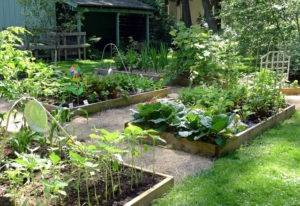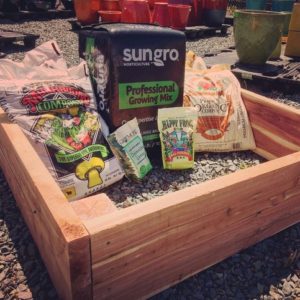-Patrick Metz-

I am getting ready to start a new garden plot. For years I have employed a technique known as double-digging to get started. The concept is simple and effective. The goal: create a deep bed of loose, well-amended soil without harming and undoing the work of the biology already in the soil – earthworms, microbes, fungi. This technique creates a beautifully cultivated plot and an excellent rooting zone for your future plants. So what’s the catch? It is labor intensive and a physically demanding task. Don’t get me wrong, I love the rewarding muscle aches and blistered-hands feeling at the end of the day, but there is another way.
I talk to a lot of customers about starting a new garden. I usually say something to the effect of, “It can be fast, good, or cheap – pick two.” Basically, you can have a beautiful garden that costs next to nothing, but it is going to take time, your time, and labor. Or you can invest in raised beds and custom soil blends and be planting in your garden today.
I choose the word invest, because in any garden your soil is your biggest asset. It is valuable, and all your successes or failures can usually be traced back to the soil. My belief is that if you are starting a new garden, invest in it up front, and it will save you time, money, and headaches down the road. Raised bed gardening is not the only way, but it is one of the best techniques to achieve that goal.
Here are some of the benefits of raised bed gardening:
- Soil Control – Here is where it all starts. Don’t buy “dirt”. Invest in your soil. Your plants will be healthier and happier from day one.
- Less Weeding – Weeds thrive where other plant life can’t. They come up quicker, grow faster, and essentially steal what water, light, and nutrients they can from more desirable plants. Healthier soil gives your plants an advantage. And weeding a contained raised bed is a manageable task, done in minutes, that does not feel like a chore.
- Soil Temperature – Germination and healthy root growth depend on warm soil temperatures. When your bed is elevated and exposed to the sun it warms up quicker. This usually means getting a quicker start each year.
- Drainage – Partially to do with the elevated nature of the bed, but also that initial investment in a loamy soil. This reduces conditions that fungus and disease usually thrive in, add that to better air circulation and you should have less of a need for fungal controls like copper and sulphur.
- Higher Yields – Again, this can be attributed to the soil, but raised beds can typically support more intensive gardening per sq.ft. Part of it is your mentality, getting the most out of a smaller space and not feeling overwhelmed at prospect of managing it.
- Neat Freak – Pretty obvious, but raised beds look good. They are contained, manageable plots, with establish pathways. It looks clean and professional, even your HOA can’t argue with that.
- Easy Breezy – When your bed is 1′ or more off the ground, there is less bending, hunching, hands and knees work. Your back thanks you. Pull up a chair, pour yourself a cocktail, enjoy your garden!

Here is our soil recipe for a raised bed – 1 bale sunshine, 4 bags compost, 5 lbs. dolomitic lime, 4 lbs. Happy Frog All Purpose fertilizer. We can also help you amend your existing soil. So, whatever path you choose, Fifth Season is here to help.
Raised beds can be bought at your local farm and garden supply (hint, hint, hint) or made from just about anything – we would suggest scouring Pinterest if you are short on ideas. But, if you decide to build your own, choose a wood that will last with exposure to the elements. Our favorites are eastern red cedar or black locust. Try and avoid lumber that has been treated, as they contain things like micronized copper and arsenic. The jury is still out on long-term effects and uptake by your plants, but we do know that these can leech into the soil. If you can find eastern red cedar, look for something with minimal sap wood (white part) and more red or orange. These natural resins in the wood help to protect it and will resist rot. A thicker board will also add to the longevity of your raised bed.

Leave a Reply